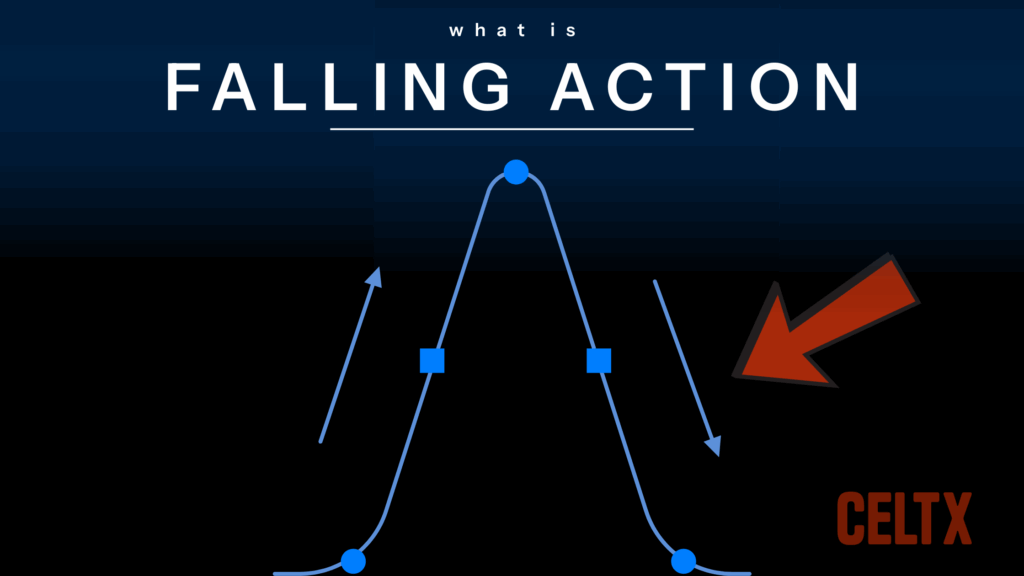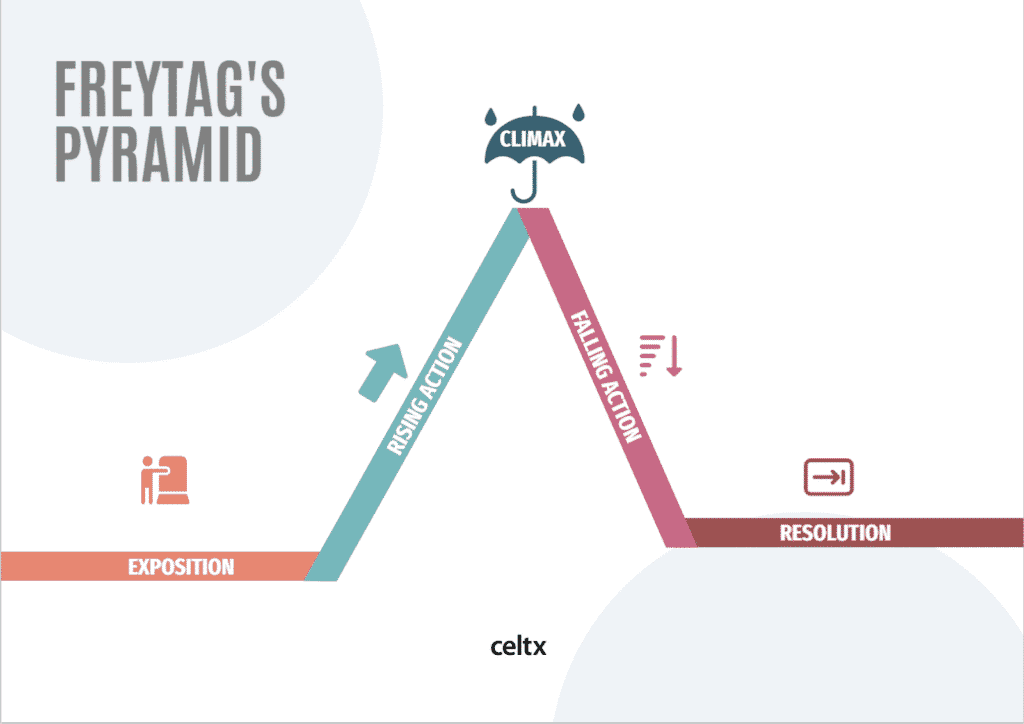
We’ve all heard of rising action and the climax of a story. Both are elements of a tried and tested story structure that writers have been using for generations. But while most writers are in the know about these, fewer pay attention to the equally important, yet often underappreciated part of the story arc.
Allow me to introduce you to… falling action!
Falling action is the narrative slope that follows your story’s climax. Tensions deflate, consequences unfold, and characters begin to come to terms with what’s just happened to them. It allows you to tie up loose ends and make your story feel whole, satisfying, and powerful.
If you’ve stumbled (get it?) across falling action for the first time, then you’ve certainly come to the right place! In today’s blog we’ll explore falling action in film, where it belongs in your story and why it matters. Also look out for some key examples in film and TV along the way.
Let’s get going…
In This Article
- What is Falling Action?
- Where It Falls In Your Story
- Why Falling Action Matters
- Examples in Film and TV
- Common Mistakes to Avoid
- FAQs
- Conclusion
What Is Falling Action?
Falling action is the part of the story that comes directly after the climax and ends just before the resolution (aka the denouement).
Yes, we’ve had the inciting incident, the epic journey, and the main conflict is resolved, but the story isn’t quite over. That’s where falling action comes in as the emotional and narrative ‘come down’.
So, what constitutes falling action? Well, it’s usually made up of four main elements:
- Characters reacting to the climax and processing emotions from it
- Remaining subplots beginning to wrap up
- Decreasing tension
- The ‘new normal’ begins taking shape
Falling action plays a key role in a narrative as it helps to ease the audience from the story’s climax into a satisfying conclusion. Without it, the transition from peak tension to the end can feel jarring or rushed.
Where It Falls in Your Story
(Yes, that pun was completely intended and we’re not ashamed to admit it!)
You may already be familiar with Freytag’s Pyramid, a model that breaks stories into five parts (the five-act structure).

In this model, you’ll see that falling action is the penultimate step bridging the height of drama (the climax) and the end (the resolution).
Most screenplay structures (such as the three-act structure or Save the Cat), falling action typically happens in Act III between the ‘final battle’ and ‘final image’.
With falling action, it can be very easy for things to fizzle out rather than leading a punchy and meaningful ending. While it is a decline in tension, it shouldn’t feel like a complete drop off. Falling action should still move the story forward just in a downward, concluding direction.
Why Falling Action Matters
As screenwriters, why should we care about falling action? Well, like all stories, it’s a crucial part of film and television narratives, to create:
1. Emotional Resolution
Falling action gives your audience emotional closure. After the high of a climax, people want to know ‘What now?’ Without falling action, characters may feel like they’ve simply disappeared, and the world of your story feels unfinished.
2. Thematic Reinforcement
This is where you can underline the themes of your story. What did your characters learn? What changed? What remained the same despite everything that happened?
3. Satisfying Endings
Think about the last time you watched a movie that ended way too quickly. It probably lacked solid falling action. By giving your story space to breathe post-climax, you can help prevent that ‘wait, that’s it?’ feeling.

4. Strong Pacing and Rhythm
Like all other story elements, falling action contributes to the overall rhythm. Just as you wouldn’t want two hours of constant rising action that doesn’t really go anywhere, you also don’t want a climax that cuts straight to the credits.
Falling action lets your audience settle, reflect, and prepare to say goodbye.
Examples in Film and TV
But it’s not quite time for us to say goodbye just yet, as it’s time to take a look at some experts at work. Here are our top five falling action examples of how the post-climax plays out in some of our favorite movies and TV shows.
Take it away!
Case Study #1 | The Lord of the Rings: The Return of the King (2003)
This film is famous (or infamous) for its extended falling action. After the climax, when Frodo destroys the Rong, there’s nearly twenty minutes of falling action.
We see:
- Frodo and Sam rescued by the eagles
- Aragorn crowned King
- Farewells in Gondor
- Frodo returning to the Shire
- Final departure to the Undying Lands
Some may argue that this falling action goes on too long. However, it does show how falling action can tie up multiple emotional threads after a massive climax, especially threads that involve a whole ensemble of characters we’ve followed for three whole movies.
Here is just one of the scenes within The Return of the King’s falling action: Aragorn finally being crowned King:
Case Study #2 | Breaking Bad: Season Five Finale (2013)
The climax happens when Walter White rescues Jesse and is mortally wounded. The falling action following this moment includes:
- Walter’s final goodbye to his family
- Jesse driving away to freedom
- Walter’s slow walk through the meth lab
- Walter’s collapse and death
Each of these moments is vital in tying up the loose ends of the overall story, as well as giving the audience time to process the consequences of Walt’s choices. As a result, the emotional tension resolves naturally and doesn’t feel forced.
Case Study #3 | Inception (2010)
After the climax in the dream world, the falling action shows:
- The team waking up on the plane
- Cobb going through customs
- The reunion he has with his children
- The spinning top (leading to an ambiguous ending)
In contrast to the Lord of the Rings ending, Inception’s is brief but just as essential to the story. Without it, the climax would feel disjointed from the resolution, leaving the audience unsatisfied.
Case Study #4 | Titanic (1997)
The climax of this epic film is the ship sinking and Jack’s subsequent death. Next, the falling action shows:
- Rose floating on the ship’s debris and being rescued
- Rose giving a false name to start her new life
- The elderly Rose finishing her story
- Rose’s final dream-like reunion with Jack aboard the Titanic in the film’s last moments
The falling action helps the audience emotionally recover and process the scale of loss, especially as the film is an adaptation of real-life events. It subtly reinforces themes of survival, memory and eternal love.
Case Study #5 | Avengers: Endgame (2019)
After the climax of the final battle and Tony’s Stark’s snap, the film devotes considerable time to falling action:
- Tony’s funeral, allowing time for grief and tribute
- Thor passing leadership of Asgard to Valkyrie
- Peter Parker reuniting with his friends
- Steve Rogers returning the Infinity Stones and choosing to stay in the past
Each of these beats gives closure to major character arcs while setting up future stories in the MCU. It’s a masterclass in using falling action to bring emotional weight to a sprawling narrative.
But the examples don’t stop there. Check out this breakdown of The Shawshank Redemption from Living Writer. Can you identify the falling action?
Common Mistakes to Avoid
Falling action tends to be a delicate part of your story, where your characters are recovering from what they’ve experienced and learning to accept a ‘new normal’. Naturally, there are some common pitfalls that writers can fall into when tying up their stories.
But don’t worry, we’re here to help you avoid these as best you can.
1. Skipping Falling Action
A story doesn’t end with the climax. While some experimental films or shorts can get away with this, most narratives feel incomplete without falling action.
Make sure you plan for at least one post-climax scene that gives emotional or narrative closure before you move onto the resolution.
2. Overextending Falling Action
On the flipside, falling action that drags on too long can sap your ending of energy. Instead, check whether every post-climax scene is necessary. Does it resolve something? Does it deepen a theme or deliver emotional payoff?
If it doesn’t, bin it!

3. Turning Falling Action into a New Climax
Falling action isn’t there to introduce a new, major conflict. Otherwise, it could undercut your original climax and throw off the pacing completely. Keep your focus on the consequences of your climax through falling action, rather than introducing a new crisis.
4. Forgetting Character Arcs
Falling action is where your characters should show how they’ve changed, or failed to change within their character arc. Highlight emotional growth in this sequence of scenes, or a complete lack of growth!
Structure matters—especially in your final acts.
Celtx’s scriptwriting software helps keep every scene purposeful.
Sign up today (it’s free)!
FAQs
How long should the falling action be?
This completely depends on how long and complex your story is. For a feature film, the falling action can last anywhere between five and ten minutes. For TV episodes, one to two scenes. For novels, it can be an entire chapter. The time doesn’t matter so much, as long as the falling action provides adequate closure.
Can I end my story straight after the climax?
Technically yes, there are no strict rules. However, if you do end on the climax, it can leave your audience emotionally unsatisfied or confused. Only cut straight from the climax to the end if the ambiguity is intentional and well-executed, like The Sopranos finale.
Is falling action the same as the resolution?
Not quite. Falling action leads into the resolution. It’s the transition. The resolution is the final moment where the story comes to an end.
Do all genres use falling action in the same way?
No. For example, in thrillers, falling action may be short and sharp. Whereas in dramas, it may be longer and more emotional. It’s also different for comedies which could include a humorous coda or wrap-up gag. But no matter the format, the function of falling action is always the same: to smoothly transition between the climax and the conclusion.
What if I have multiple storylines?
If this is the case, you may need separate falling action beats for each storyline. Consider each storyline’s emotional weight and wrap up secondary arcs quicker so you can linger on the main one for longer.

Conclusion
Falling action is more than a storytelling afterthought. It’s the glue that holds your narrative together after the peak moment has passed. It allows characters to reflect, audiences to breathe, and stories to land with grace rather than a thud.
In your script, don’t neglect this part of the structure. Use it to wrap up your themes, show character evolution, and lead your audience smoothly into the final act of your story.
Whether it’s Frodo sailing into the West, Jesse screaming in freedom, or Cobb reuniting with his kids, falling action can provide some of the most emotionally powerful moments in your entire story.
So, when you reach your climax, don’t stop climbing. Let your story fall… thoughtfully.
More on story structure:
- The Climax: How to Write the Moment That Changes Everything
- How to End a Screenplay (A List of 21 Different Ways)
- Yes, You Need a Screenplay Outline. Here’s How to Write One
